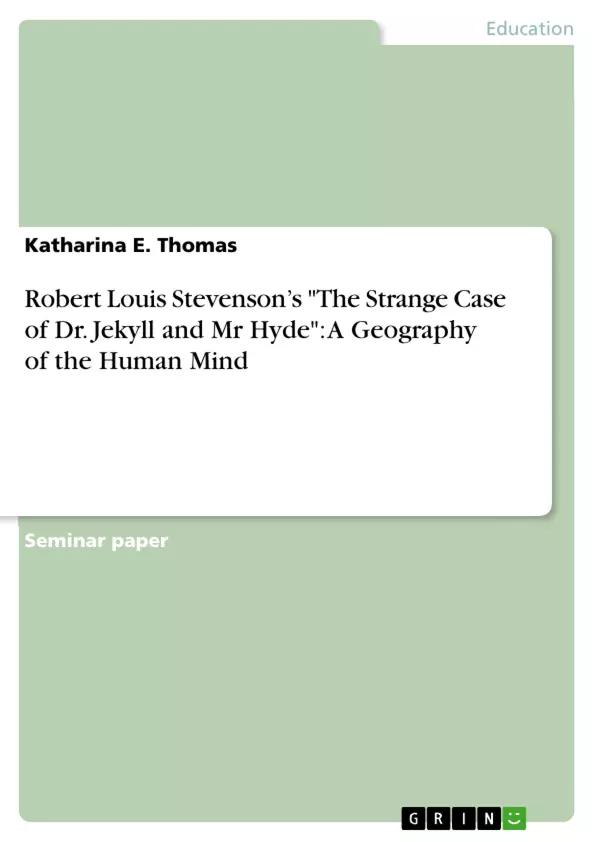Robert Louis Stevenson’s novel The Strange Case of Dr. Jekyll and Mr. Hyde presents a landscape that can be read as a geography of the human mind. The two separate dwelling- places of Dr. Jekyll and his alter ego, Mr. Hyde, can be analyzed in psychoanalytical terms as representing the conscious and the unconscious. The suppressed desires of the unconscious, which are related to a discourse of homosexuality underwriting the novel, return to haunt and ultimately destroy the mind of Dr. Jekyll.
This paper will examine how the city functions as a mirror of the human mind. It takes a more general approach at first, analyzing different descriptions of the city throughout the novel. As a second step towards establishing the evidence to support the thesis, it will be necessary to take a closer look at the specific geography of Dr. Jekyll’s psyche, arguing that the separate dwelling places of Dr. Jekyll and Mr. Hyde represent the conscious and the unconscious in terms of Freudian psychoanalysis. Finally, the paper will examine how this reading allows for an interpretation of Dr. Jekyll’s hidden desires as being related to homosexuality.
Other interpretations concerning these vices are possible and not mutually exclusive with the one pursued in this paper, as, for example, a reading of Jekyll’s mental and physical descent as due to alcoholism and drug abuse. However, a broader analysis taking into account these additional interpretations would be beyond the scope of this paper. It will therefore focuse on the evidence that supports the idea of a homosexual discourse in the novel.
Table of Contents
- Robert Louis Stevenson’s Novel The Strange Case of Dr. Jekyll and Mr. Hyde: A Geography of the Human Mind
- The City as a Mirror of the Human Mind
- London as a Landscape of Anxiety and Fear
- The Gloominess of Soho and Utterson’s House
- Dr. Jekyll’s and Mr. Hyde’s Dwelling Places: A Psychoanalytical Reading
- The Orderly Façade of Dr. Jekyll’s House and the Influence of Mr. Hyde
- Dr. Jekyll’s Laboratory and Mr. Hyde’s House
- The Unconscious Returns: The Inevitability of the Transformation
- Homosexuality as a Hidden Theme in the Novel
- Queer Street and the Carew Murder
- The Scene of the Carew Murder
Objectives and Key Themes
This paper examines the geography of London in Robert Louis Stevenson’s novel The Strange Case of Dr. Jekyll and Mr. Hyde, arguing that the city functions as a reflection of the human mind. It analyzes descriptions of London throughout the novel and focuses on the separate dwelling places of Dr. Jekyll and Mr. Hyde, suggesting a psychoanalytical reading of these locations as representing the conscious and unconscious. The paper also explores the possibility of a homosexual discourse underlying the novel, connecting this theme to Dr. Jekyll’s hidden desires and the events surrounding the Carew murder.
- The city as a reflection of the human mind
- The psychoanalytical interpretation of Dr. Jekyll’s and Mr. Hyde’s dwelling places
- The relationship between the conscious and the unconscious
- The potential for a homosexual discourse within the novel
- The suppression and manifestation of hidden desires
Chapter Summaries
The paper begins by exploring the descriptions of London in The Strange Case of Dr. Jekyll and Mr. Hyde, focusing on the atmosphere of gloom and darkness that pervades the city. The author argues that these descriptions suggest parallels to the human mind, making a psychoanalytical reading of the novel plausible.
Next, the paper analyzes the respective dwelling places of Dr. Jekyll and Mr. Hyde. Dr. Jekyll’s house, though surrounded by decay, is described as luxurious and comfortable, representing the doctor’s outward façade. However, signs of anxiety and a distorted mind are present even in this seemingly ordered setting. Mr. Hyde’s house, located in Soho, is described as similar in luxury and comfort, suggesting a connection to Dr. Jekyll’s dwelling place.
The paper then examines how the novel reveals the inescapability of the unconscious. Despite Dr. Jekyll’s efforts to suppress his dark desires by separating them into a separate persona, Mr. Hyde eventually returns with increased vehemence. The author presents examples of these transformations, emphasizing the unconscious’s gradual control over Dr. Jekyll’s mind.
Finally, the paper explores the possibility of a homosexual discourse underlying the novel, connecting this theme to Dr. Jekyll’s hidden desires and the events surrounding the Carew murder. The author examines the use of language, including the term “Queer Street,” and the scene of the Carew murder, suggesting that Dr. Jekyll’s suppressed desires are related to homosexuality.
Keywords
The key themes of this paper include the psychoanalytical reading of a literary text, the city as a reflection of the human mind, the relationship between the conscious and unconscious, the suppression of desires, and the potential for a homosexual discourse within the novel. The paper draws upon the work of Sigmund Freud and employs psychoanalytic theory to interpret the geography of London and the characters’ dwelling places in The Strange Case of Dr. Jekyll and Mr. Hyde.
- Citar trabajo
- Katharina E. Thomas (Autor), 2008, Robert Louis Stevenson’s "The Strange Case of Dr. Jekyll and Mr Hyde": A Geography of the Human Mind, Múnich, GRIN Verlag, https://www.grin.com/document/172966



